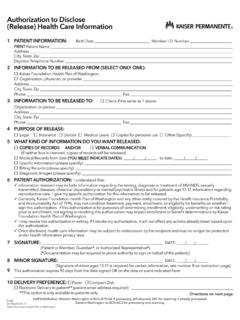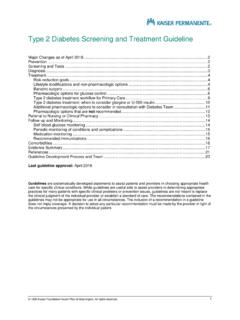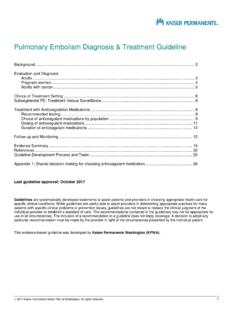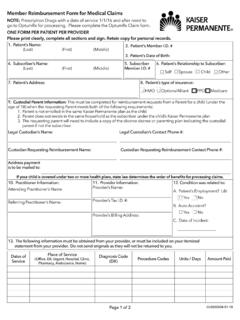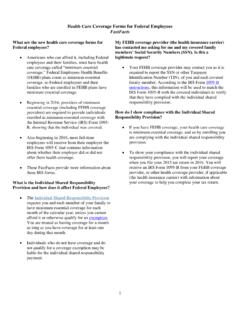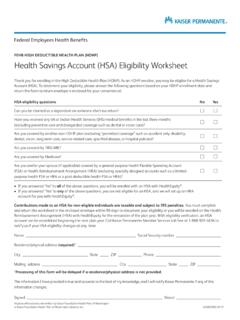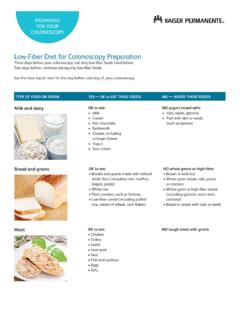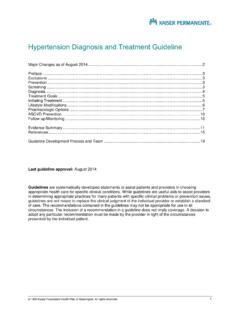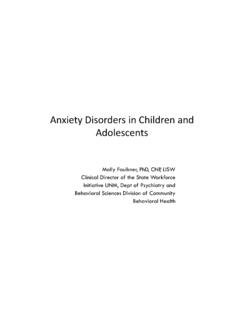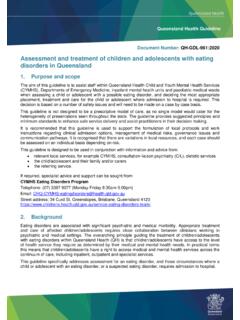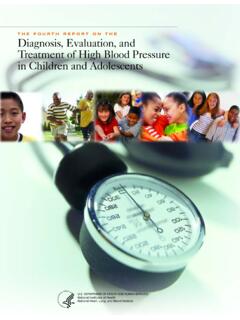Transcription of Weight Management Guideline: Children and Adolescents
1 2006 Kaiser Foundation Health Plan of Washington. All rights reserved. 1 Weight Management in Children and Adolescents Screening and Intervention Guideline Prevention .. 2 Nutrition .. 2 Healthy eating behaviors .. 2 Physical activity .. 3 Screening .. 3 3 Interventions .. 4 Goals .. 4 Strategies to help with Weight loss .. 5 Behavior change counseling using the 5A approach .. 5 Lifestyle modifications .. 8 Pharmacotherapy not recommended .. 10 Bariatric surgery .. 10 Comorbidities .. 10 Comorbidity screening .. 10 Depression screening .. 10 Sleep apnea screening not 10 Evidence Summary.
2 11 References .. 12 Guideline Development Process and Team .. 13 Last guideline approval: December 2012 Guidelines are systematically developed statements to assist patients and providers in choosing appropriate health care for specific clinical conditions. While guidelines are useful aids to assist providers in determining appropriate practices for many patients with specific clinical problems or prevention issues, guidelines are not meant to replace the clinical judgment of the individual provider or establish a standard of care. The recommendations contained in the guidelines may not be appropriate for use in all circumstances.
3 The inclusion of a recommendation in a guideline does not imply coverage. A decision to adopt any particular recommendation must be made by the provider in light of the circumstances presented by the individual patient. 2 Prevention The following recommendations for prevention of overweight and obesity in Children and Adolescents are adapted from the 2010 Scottish Intercollegiate Guidelines Network (SIGN) guideline on managing obesity. Information on nutrition, healthy eating behaviors, and physical activity are also available in patient-education format.
4 See Parenting Your Child. Nutrition Birth to 6 months Breastfeeding is recommended for all infants, until at least 6 months of age. If possible, continue until baby is at least 12 months old. (If breast milk is not possible, use formula with iron.) Between 4 and 6 months of age, complementary foods become necessary to support growth, satisfy hunger, and supplement energy and nutrient needs. Solid foods should focus on fruits, vegetables, and iron-rich foods. Introduce lean meats, beans, and legumes at 6 months. 6 to 12 months A serving size is the size of the child s fist; allow the child to decide how much of a food to eat.
5 Consider introducing healthy finger foods around 8 months. Emphasize fruits, vegetables, lean meats, and low-fat dairy products (yogurt and cheese). Limit juice and other sweetened beverages, and encourage plain, unsweetened water to satisfy thirst. 1 to 3 years A serving size is the size of the child s fist. Allow the child to decide how much of a food to eat; parents decide when, where, and what to feed. Allow the child to decide if he/she is hungry and how much to eat at mealtime. Do not bribe or push more foods than the child wants. Children need 3 meals a day, with 1 2 snacks in between.
6 Children aged 12 24 months may be given whole milk or low-fat milk, depending on their growth rate and other dietary intake. Children older than 24 months do not need whole milk; they should be given skim or low-fat milk (1% or 2%). Focus on fruits, vegetables, lean meats, and low-fat dairy products (cheese and yogurt). Limit foods with high fat or sugar content, including fried foods, fast food, and processed foods. Limit juice, sports drinks, soda, and other sweetened beverages. Drink water to satisfy thirst. 4 to 17 years Stress the importance of fruits and vegetables at every meal.
7 Encourage breakfast daily. Limit snacking during the day, especially with processed foods. Encourage set times for healthy snacks to discourage grazing. Limit juice, sports drinks, soda, and other sweetened beverages. Drink water to satisfy thirst. Focus on fruits, vegetables, whole grains, lean meats, and low-fat cheeses and yogurt. Limit foods with high fat or sugar content, including fried foods, fast food, and processed foods. If dessert is offered, make it a normal ending to the meal. Do not bribe or reward the child for cleaning his/her plate.
8 Healthy eating behaviors Eat regular family meals, including breakfast, without distractions ( , television) when possible. Limit meals eaten outside the home, especially those at fast-food restaurants. When eating out, include fruit and vegetable options. 3 Physical activity Engage in 30 60 minutes of moderate- to vigorous-intensity physical activity most days per week, starting at age 6. For Children aged 5 and younger, encourage several periods of active play per day. Develop a routine or planned time for active play every day, such as an after-school activity or play before starting homework.
9 Limit sedentary time ( , time spent using computer, playing video games, watching television). Screening The Preventive Services Task Force (USPSTF) recommends that clinicians screen Children aged 6 years and older for obesity. Measure height and Weight , and calculate BMI percentile at the following frequency: Every visit in primary and consultative care. Every hospital admission. The Centers for Disease Control and Prevention (CDC) website has a BMI percentile calculator for Children and teens aged 2 19 ( ). The calculator provides BMI and the corresponding BMI-for-age percentile for girls and for boys.
10 There is insufficient evidence regarding the utility of measuring waist circumference among Children and Adolescents to predict future health risks. Diagnosis Table 1. Child and adolescent classification of Weight by BMI percentile1 Clinical classification BMI percentile Healthy Weight 5th 84th percentile Overweight 85th 94th percentile Obese At or above 95th percentile 1 The BMI percentile indicates the relative position of the child s BMI number among Children of the same age and gender. There are no routine lab tests recommended for diagnosing obesity.

